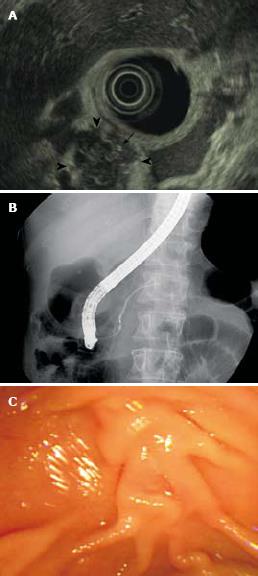Copyright
©2009 The WJG Press and Baishideng.
World J Gastroenterol. Feb 28, 2009; 15(8): 1010-1013
Published online Feb 28, 2009. doi: 10.3748/wjg.15.1010
Published online Feb 28, 2009. doi: 10.3748/wjg.15.1010
Figure 1 Abdominal US and CT at admission.
A: Abdominal US revealed an irregularly contoured, hypoechoic, cystic lesion in the head of the pancreas, with calcification at the center of the mass (arrow); B: abdominal CT demonstrated an inhomogeneous lobulated multicystic mass of 4.5 cm × 2.0 cm in the head and uncinate process of the pancreas, with central calcification (arrow).
Figure 2 MRI of the pancreatic mass.
A and B: Gadolinium-enhanced T-1 weighted image of the sharply delineated multiloculated mass in the pancreas head, with peripheral and central areas of enhancement; C: T-2 weighted image of the heterogeneous mass with increased and decreased signal intensities.
Figure 3 EUS and ERCP findings.
A: Lobulated multicystic lesion of heterogeneous echotexture and focal calcification (arrow); B: endoscopic view of the normal appearance of the ampulla with no mucus secretion from its orifice; C: fluoroscopic view of no communication between the pancreatic duct and the cystic mass.
Figure 4 Histological image of resected specimen.
A: Photograph showing the epithelioid granuloma with central caseous necrosis (HE, original magnification, × 100); B: multinucleated Langhans’ giant cell with surrounding lymphocytes (arrow) (HE, original magnification, × 400).
- Citation: Hong SG, Kim JS, Joo MK, Lee KG, Kim KH, Oh CR, Park JJ, Bak YT. Pancreatic tuberculosis masquerading as pancreatic serous cystadenoma. World J Gastroenterol 2009; 15(8): 1010-1013
- URL: https://www.wjgnet.com/1007-9327/full/v15/i8/1010.htm
- DOI: https://dx.doi.org/10.3748/wjg.15.1010












